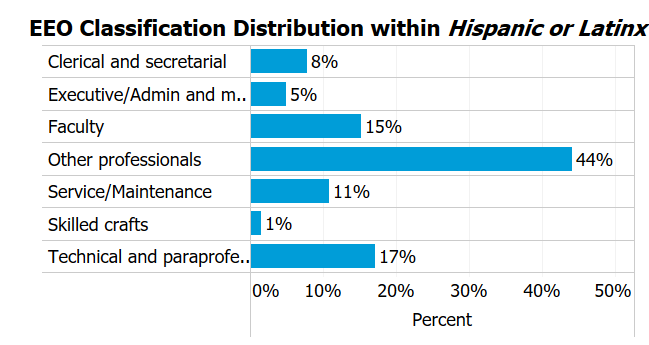Strategic Metrics
At SLCC, becoming an HSI is an integral part of our identity. We follow Gina Garcia's Typology of Hispanic Serving Institution Organizational Identities to define our approach to the "serving" aspect of HSI. This enables us to have a shared language and culture as we undertake this important work. In practice, we view "servingness" as an intentional transition of our organizational structures using available resources and programming.

Our goals of reaching the HSI designation and “intentionally serving Latino students, while serving all” using the Seal of Excelencia framework are aligned with and critical to SLCC’s strategic planning. Explore the following metrics related to those goals.
Seal of Excelencia

Institutions have accurate data and positive momentum among six key data areas:
- Enrollment of Latino students;
- Retention of Latino students;
- Transfer in and out of Latino students;
- Financial support for Latino students;
- Representation of Latinos in administration, faculty, and staff to further model success; and,
- Degree completion of Latino students.
Institutions that intentionally implement and advance evidence-based programs and policies in six key practice areas to achieve desired results for Latino students include:
- Enrollment of Latino students;
- Retention of Latino students;
- Transfer in and out of Latino students;
- Financial support for Latino students;
- Representation of Latinos in administration, faculty, and staff to further model success; and,
- Degree completion of Latino students.
Institutions demonstrate leadership impact and how the institution aligns data and practice to improve Latino student success according to the following five leadership areas:
- Mission and strategy – where aspects of the institution’s mission and strategy are articulated and implemented to intentionally include Latino students’ success.
- Data and practice – how disaggregated data (by race and ethnicity) and institutional practices are aligned to inform initiatives that improve Latino student success.
- Human resources – how recruitment, onboarding, and professional development (especially for faculty) prioritize serving Latino students and the institutional community.
- Communications – where internal and external communications are leveraged to share information making the intentionality to serve Latino students clear. This can keep momentum building toward goals set by the college and across the institution and community.
- Institutional culture – how the institution articulates authentically its intentionality in SERVING Latino students, including how it is cultivated and supported.
Increase Diversity in Hiring and Retention
All Employees Demographic Data

Full-time Faculty Demographic Data

Classification Distribution of All Hispanic Employees
Category: Hispanic or Latinx
Employees: 204
Percent: 13.7%

National research suggests that student success increases when students see their racial, ethnic and/or gender identity reflected in faculty and staff. The Hispanic or Latinx/a/o Annualized Full-Time Equivalent (AFTE) of students at SLCC is 23%. The percent of all employees who identify as Hispanic or Latinx/a/ is 13.7% with the percent of full-time faculty identifying as such is 8.9%.